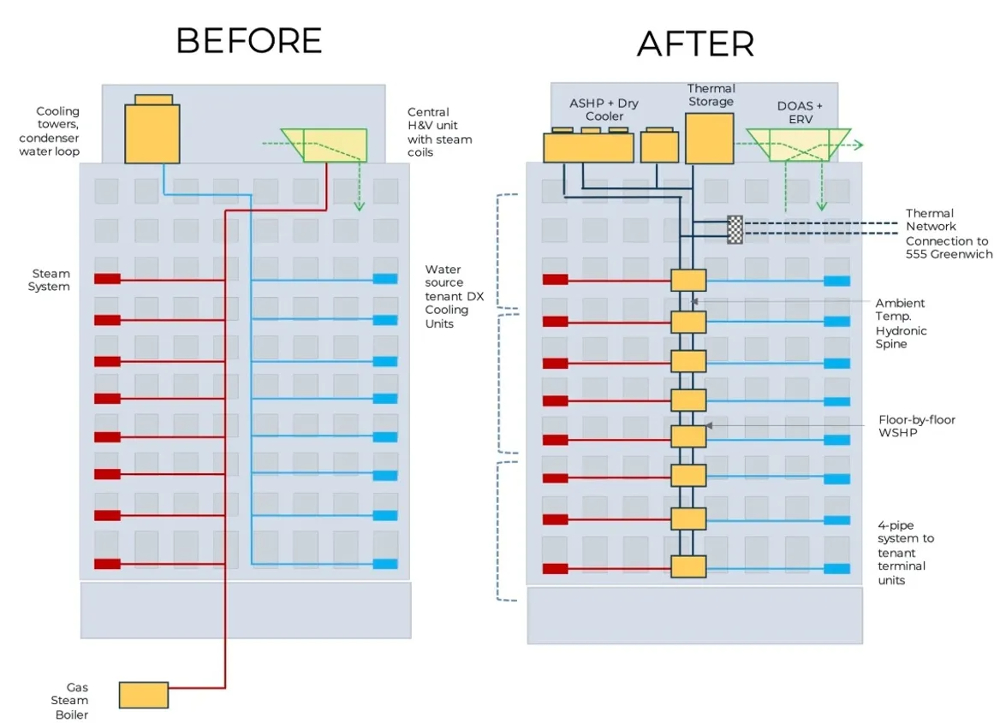Sign up for daily news updates from CleanTechnica on email. Or follow us on Google News!
Local Law 97 in New York City requires buildings of more than 25,000 square feet (2323 sq. m) to meet specific emissions limits, which become more stringent in 2030, or face hefty fines. There is a 17-story concrete building built in 1931 at 345 Hudson Street in the SoHo (south of Houston) district at the south end of Manhattan. The owners are thinking ahead to 2030 and installing heat pumps now to meet the requirements of Local Law 97, rather than waiting until the last minute.
How do you carbonize an almost century-old building? By replacing the separate heating and air conditioning systems with one that does both jobs and slashes emissions by up to 90 percent. The project will replace the methane-burning furnaces used today to send hot water to the radiators located throughout the building and the separate air conditioning units. Not only will the new system use ultra-efficient heat pumps, it will also capture and reuse waste heat that would otherwise be released into the atmosphere.
Heat Pumps Are More Efficient
According to Canary Media, the state of New York is backing the project at 345 Hudson Street because it may demonstrate how the other 6000 high rise buildings in New York City can reduce the amount of carbon they contribute to the environment. As part of the Empire Building Challenge, the New York State Energy Research and Development Authority (NYSERDA) awarded $5 million to the 345 Hudson project in 2022. The project has also secured more than $30 million in private funding.
Project leader Benjamin Rodney estimates that once the project is complete in 2030, the building will use 25 percent less energy than a conventional design and reduce greenhouse gas pollution by 70 percent relative to 2019 levels. As the grid gets cleaner in the years to come, he expects that figure to climb to 90 percent by 2035. The deep emissions cuts will allow the building owner, Hudson Square Properties, to avoid more than $200,000 in fines annually starting in 2030. What’s more important is that it could help other building owners determine how best to eliminate emissions. That’s a crucial task given that nearly 70 percent of the city’s carbon pollution stems from the fossil fuels used to heat and power its buildings.
One System Instead Of Two

Like most New York City high rise buildings, 345 Hudson Street has been heated and cooled by two separate systems. On cold days, steam has been pumped through radiators. On hot days, chilled water has flowed through pipes and absorbed ambient heat, which was then released into the atmosphere via a cooling tower on the roof.
But dumping thermal energy into the sky instead of redirecting it is a wasted opportunity, according to Rodney. Buildings often need cooling and heating at the same time in different spaces, especially in the shoulder seasons; for example, when a data center operating on one floor needs cooling but an office on another floor needs heat.
To redistribute heat, Rodney’s team is installing a kind of thermal circulatory system. It consists of a network of new and existing pipes that will carry a constant flow of water around the building. Each floor will have a heat pump that can then tap into or reject heat from this system in order to keep its occupants comfortable. The design is an example of a thermal energy network and is far more efficient than having two isolated conditioning systems that don’t interact, Rodney said. “You’re creating this energy balance throughout the building.”
Air Source & Water Source Heat Pumps
For the decarbonization retrofit at 345 Hudson Street, a basement gas boiler is being replaced with air source heat pumps on the roof and water source heat pumps throughout the building. All of them can pull heat from or dump heat into a central artery known as an “ambient temperature hydronic spine.” This allows heat to be reused that would otherwise be released into the atmosphere.
Rodney’s team is installing the water-source heat pumps floor by floor as tenant leases expire, with four in place so far. This phased approach “is a fantastic way to turn the building over” because it’s much less disruptive to occupants, Ted Tiffany, a senior technical lead at the Building Decarbonization Coalition, told Canary Media. Tiffany is not involved in the 345 Hudson Street project.
The retrofit includes three air source heat pumps on the roof that can provide additional heating or cooling using the outside air as a thermal source or sink. Another system sitting on top of the building, called an energy recovery ventilator, will deliver even more efficiency gains by using air leaving the structure to pre-cool or pre-heat filtered air coming in.
A Miniature District Heating System
In addition, the 345 Hudson Street building will get some help from another building nearby. Its water-based network will be physically connected to the 555 Greenwich Street building next door, which already has an energy efficient ground source heat pump system in place. Underneath 555 Greenwich are 68 foundation columns, or piles, reaching 120 feet into the ground, where the temperature rarely dips below about 45 degrees Fahrenheit, even in the depths of winter. The heat pump uses this stability to its advantage: It’s connected to water and antifreeze-filled pipes within the piles that allow it to move heat efficiently into and out of the subterranean environment. The system is also a seasonal battery that can sequester excess heat during the summer so that it can be recaptured when needed in the winter.
Heat redistribution within and among buildings is common in Scandinavian countries, where district heating systems are used frequently. But this project “is one of the first times in New York and the United States in which heat is being shared in this way,” said Jared Rodriguez, principal at Emergent Urban Concepts and an adviser to NYSERDA on the Empire Building Challenge. He added that utilizing energy resources efficiently is a critical part of the playbook for retrofitting large buildings, hence the importance of trying out ways to recycle their excess heat.
In the future, other buildings could join the thermal energy network connecting 345 Hudson and 555 Greenwich. That would drive down carbon pollution further by reusing more heat instead of throwing it away, helping relieve some of the pressure on the grid as heating continues to electrify, Rodriguez said. Even during hot summer days when office buildings may be pushing out a lot of heat, there are entities like laundromats and large hotels that need it, Rodriguez noted. He can picture that future: “City Winery is not too far away, and they have a big hot water load.”
The Takeaway
Making heating and cooling systems for large buildings is smart thinking. Of course all this new technology is not cheap, but think of the carbon and methane emissions that will be avoided by not installing a new gas boiler at 345 Hudson Street with a useful life of 30 years or more. Just imagine what reducing the emissions from over 6000 high rise buildings in New York City by 70 percent or more could do for air quality in the Big Apple — and the Earth.
Readers in Scandinavia may snicker up their sleeves about clueless Americans who are just now discovering the virtues of district heating — virtues they have known about for many decades — but better late then never. The Earth is not as friendly to human habitation as it once was and we must either adapt or pay the price. No matter how far behind America may be, the only way way to catch up is to get started. The lessons learned from 345 Hudson Street will spread throughout New York City as new technologies are tested and improved.
Humans have been wasting three quarters of the energy in the fossil fuels they rely on for 150 years. It’s time to smarten up — or perish.
Have a tip for CleanTechnica? Want to advertise? Want to suggest a guest for our CleanTech Talk podcast? Contact us here.
Latest CleanTechnica.TV Videos
[embedded content]
Advertisement
CleanTechnica uses affiliate links. See our policy here.
- SEO Powered Content & PR Distribution. Get Amplified Today.
- PlatoData.Network Vertical Generative Ai. Empower Yourself. Access Here.
- PlatoAiStream. Web3 Intelligence. Knowledge Amplified. Access Here.
- PlatoESG. Carbon, CleanTech, Energy, Environment, Solar, Waste Management. Access Here.
- PlatoHealth. Biotech and Clinical Trials Intelligence. Access Here.
- Source: https://cleantechnica.com/2024/06/19/heat-pumps-decarbonizing-a-17-story-building-in-manhattan-built-in-1931/




